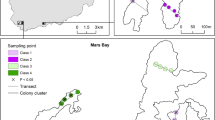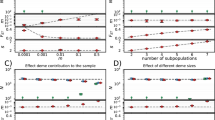Abstract
The genetic differentiation of populations is usually studied by using the equilibrium theory of Wright's infinite island model. In practice, however, populations are not always in equilibrium, and the number of subpopulations is often very small. To get some insight into the dynamics of genetic differentiation of these populations, numerical computations are conducted about the expected gene diversities within and between subpopulations by using the finite island model. It is shown that the equilibrium values of gene diversities (HS and HT) and the coefficient of genetic differentiation (GST) depend on the pattern of population subdivision as well as on migration and that the GST value is always smaller than that for the infinite island model. When the number of migrants per subpopulation per generation is greater than 1, the equilibrium values of HS and HT are close to those for panmictic populations, as noted by previous authors. However, the values of HS, HT and GST in transient populations depend on the pattern of population subdivision, and it may take a long time for them to reach the 95 per cent range of the equilibrium values. The implications of the results obtained for the conservation of genetic variability in small populations are discussed. It is argued that any single principle should not be imposed as a general guideline for the management of small populations.
Similar content being viewed by others
Article PDF
References
Allendorf, F W. 1983. Isolation, gene flow, and genetic differentiation among populations. Schonewald-Cox, C. M., Chambers, S. M., MacBryde, B. and Thomas, L. (eds.) In Genetics and Conservation, Benjamin/Cummings, pp. 51–65.
Allendorf, F W, and Phelps, S R. 1981. Use of allelic frequencies to describe population structure. Can J Fish Aquat Sci, 38, 1507–1514.
Chambers, S M. 1983. Genetics principles for managers, Schonewald-Cox, C. M., Chambers, S. M., MacBryde, B. and Thomas, L. (eds.) In Genetics and Conservation, Benjamin/Cummings, pp. 15–146.
Crow, J F, and Aoki, K. 1984. Group selection for a polygenic behavioral trait: Estimating the degree of population sub-division. Proc Natl Acad Sci USA, 81, 6073–6077.
Endler, J A. 1977. Geographic Variation, Speciation, and Clines, Princeton University Press, Princeton, N.J., U.S.A.
Frankel, O H. 1983. The place of management in conservation, Schonewald, C. M., Chambers, S. M., MacBryde, B. (eds.) In Genetics and Conservation, Benjamin/Cummings, pp. 1–14.
Frankel, O H, and Soulé. 1981. Conservation and Evolution. Cambridge University Press, Cambridge.
Franklin, I R. 1980. Evolutionary change in small populations, Soulé, M. and Wilcox, B. (eds.) In Conservation Biology: An Evolutionary-Ecological Perspective, Sinauer Associates, Sunderland, MA, U.S.A., pp. 135–149.
Golding, G B, and Strobeck, C. 1983. Variance and covariance of homozygosity in a structured population. Genetics, 104, 513–529.
Kimura, M, and Maruyama, T. 1971. Pattern of neutral polymorphism in a geographically structured population. Genet Res, Camb, 18, 125–131.
Kimura, M, and Ohta, T. 1971. Theoretical Aspects of Population Genetics, Princeton University Press, Princeton, N.J., U.S.A.
Latter, B D H. 1973. The island model of population differentiation: a general solution. Genetics, 73, 147–157.
Lewontin, R C. 1974. The Genetic Basis of Evolutionary Change, Columbia University Press, New York.
Li, W-H. 1976. Effects of migration on genetic distance. Amer Natur, 110, 841–847.
Li, W-H, and Nei, M. 1975. Drift variances of heterozygosity and genetic distance in transient states. Genet Res, Camb, 25, 229–248.
Maruyama, T. 1970. Effective number of alleles in a subdivided population. Theor Popul Biol, 1, 273–306.
Nei, M. 1973. Analysis of gene diversity in subdivided populations. Proc Natl Acad Sci USA, 70, 3321–3323.
Nei, M. 1975. Molecular Population Genetics and Evolution. North-Holland, Amsterdam.
Nei, M, and Feldman, M W. 1972. Identity of genes by descent within and between populations under mutation and migration pressures. Theor Popul Biol, 3, 460–465.
Nei, M, Chakravarti, A, and Tateno, Y. 1977. Mean and variance of FST in a finite number of incompletely isolated populations. Theor Popul Biol, 11, 291–306.
Ralls, K, Ballou, J, and Brownell, R L. 1983. Genetic diversity in California sea otters: theoretical considerations and management implications. Biol Conserv, 25, 209–232.
Takahata, N. 1983. Gene identity and genetic differentiation of populations in the finite island model. Genetics, 104, 497–512.
Wright, S. 1931. Evolution in Mendelian populations. Genetics, 16, 97–159.
Wright, S. 1951. The genetical structure of populations. Annals of Eugenics, 15, 323–354.
Wright, S. 1969. Evolution and the Genetics of Populations, Vol. 2, The Theory of Gene Frequencies, University of Chicago Press, Chicago, IL, U.S.A.
Author information
Authors and Affiliations
Rights and permissions
About this article
Cite this article
Varvio, SL., Chakraborty, R. & Nei, M. Genetic variation in subdivided populations and conservation genetics. Heredity 57, 189–198 (1986). https://doi.org/10.1038/hdy.1986.109
Received:
Issue date:
DOI: https://doi.org/10.1038/hdy.1986.109
This article is cited by
-
Effects of subpopulation extinction on effective size (Ne) of metapopulations
Conservation Genetics (2023)
-
Assessing the influence of the amount of reachable habitat on genetic structure using landscape and genetic graphs
Heredity (2022)
-
A greater yellowstone ecosystem grizzly bear case study: genetic reassessment for managers
Conservation Genetics Resources (2022)
-
Differing, multiscale landscape effects on genetic diversity and differentiation in eastern chipmunks
Heredity (2020)
-
Fragmenting fragments: landscape genetics of a subterranean rodent (Mammalia, Ctenomyidae) living in a human-impacted wetland
Landscape Ecology (2020)



